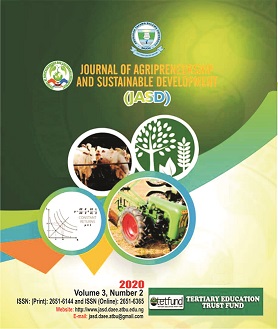DISTRIBUTION OF AVAILABLE TRACE ELEMEMTS IN TERMITARIUM AND ADJACENT SOILS IN GWAGWALADA AREA COUNCIL, FCT, ABUJA, NIGERIA
DOI:
https://doi.org/10.59331/jasd.v3i2.117Keywords:
Abuja, Adjacent soils, Available, Gwagwalada, Distribution, Trace elements, TermitariumAbstract
The study was conducted to assess some important physico-chemical properties and micronutrient status of termitaria soils compared with the surrounding adjacent undisturbed soils around Gwagwalada, Abuja. A reconnaissance survey of the study area was carried out and six (6) different locations with termite mounds were identified. Soil samples from the termite mounds as well as from adjacent lands were collected, bulked separately prepared and analysed in the laboratory for some important physico-chemical properties as well as four metallic micronutrients, (copper (Cu), manganese (Mn), zinc (Zn) and iron (Fe)). The result showed that, all the termite mounds have higher clay fractions ranging from 22% to 34% which falls in the textural class of sandy loam. Soil pH (in water) of the termitaria ranges from 5.4 to 6.7, while in the adjacent soils was 6.1 to 6.7. Organic carbon (OC), Effective Cation Exchange Capacity (ECEC), calcium (Ca) and magnesium (Mg) were generally higher in the termitaria soils than the adjacent soils, while sodium (Na) and potassium (K) were lower in the termitaria. The result of micronutrients status of the termitaria soils varied based on location, but the adjacent soils generally gave higher values for all the micronutrients than the termitaria. These attributes indicate more desirable characteristics for crop production in termitaria soils. The termitaria soils could thus be used as incidentalb fertilizer that could improve crop production at least on small scale.
Downloads

Downloads
Published
How to Cite
Issue
Section
License
Copyright (c) 2022 Journal of Agripreneurship and Sustainable Development

This work is licensed under a Creative Commons Attribution 4.0 International License.






